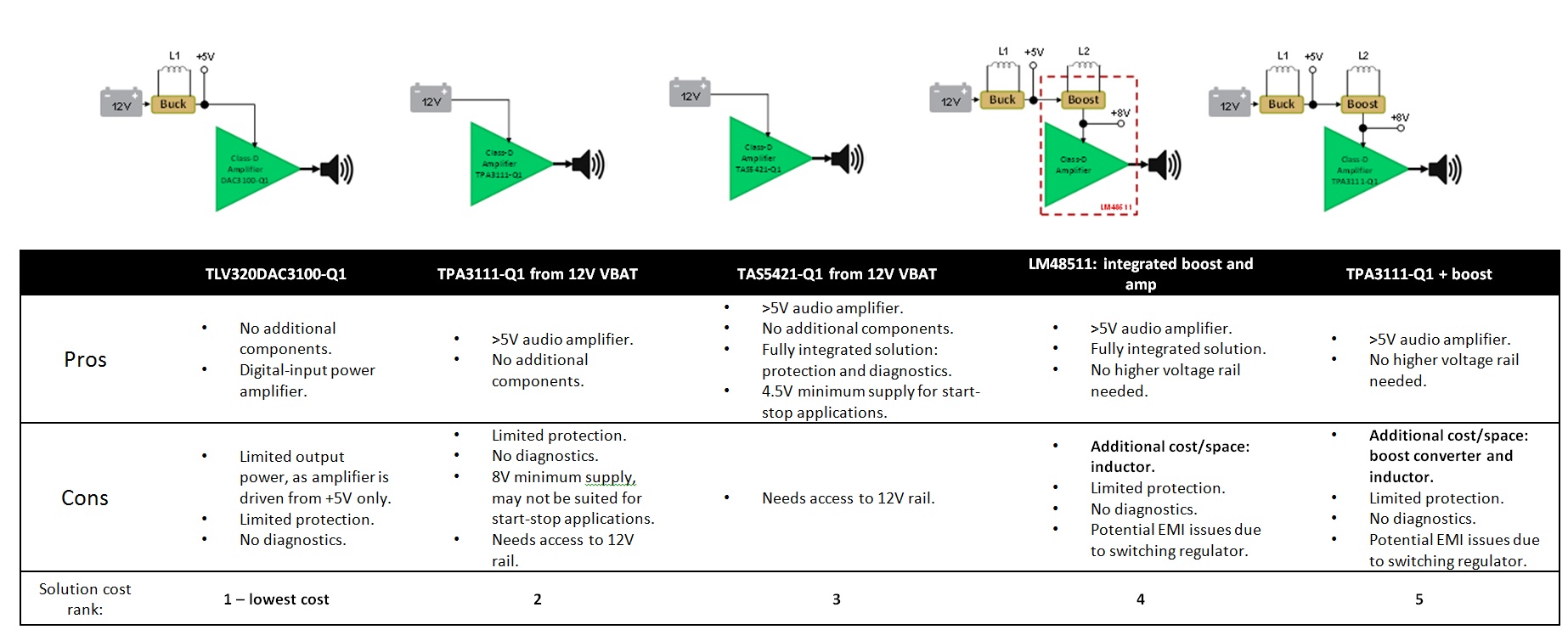SSZTCU1 april 2015 TAS5421-Q1 , TLV320DAC3100-Q1
Apr 17, 2015
The automotive instrument cluster has evolved from a basic display of information and statuses to include a variety of gauges, indicators and lights, as well as acoustical effects.
Depending on the target customer base for the vehicle, you can implement an instrument cluster audio subsystem in multiple ways. Higher-end systems prioritize higher sound pressure level (SPL), audio quality and reliability, while cost is a top priority in lower-end systems.
 Figure 1 Automotive instrument
cluster
Figure 1 Automotive instrument
clusterThere are a few different ways to implement sound for an automotive instrument cluster: a buzzer (combined with a driving circuit) or Class-AB and Class-D audio amplifiers (combined with speakers).
Buzzers
Buzzers produce a constant tone or buzzing sound. Some of their advantages are: low cost, low power (as they need only around 25mA of current), and can be driven directly from most outputs or, most commonly, from a transistor driver.
Although still common and low cost, a buzzer-based instrument cluster is trending down as original equipment manufacturers (OEMs) place a greater emphasis on an improved user experience, which requires more complex sounds than simple chimes.
 Figure 2 Typical buzzer-based
instrument cluster block diagram: Audio PWM signal, buzzer driver circuitry and
buzzer
Figure 2 Typical buzzer-based
instrument cluster block diagram: Audio PWM signal, buzzer driver circuitry and
buzzerClass-AB and Class-D Audio Solutions
Alternative, and more complex instrument cluster topologies, include Class-AB and Class-D audio amplifiers. As mentioned above, these audio amplifiers are becoming the top choice for instrument cluster system designers to allow OEMs to tailor a driving experience with improved sound quality.
Much has been said about how Class-AB audio amplifiers are more cost-effective than their Class-D counterparts. When considering the integrated circuit (IC) itself this may be true, but system designers must consider the cost of the whole audio solution.
For example, the fundamental differences in efficiency between Class-AB and Class-D audio amplifiers have an impact on the audio-solution cost. The lower-efficiency Class-AB amplifier requires more complex and expensive thermal management. Expensive heat sinks and an additional printed circuit board (PCB) area for thermal dissipation are common downsides to using Class-AB amplifiers.
Class-D amplifiers require an external inductor that adds some cost to the solution, but with new automotive-grade low-cost inductors, you can minimize the external inductor cost. With this in mind – and with instrument clusters being a very space-constrained application – Class-AB amplifiers are no longer the preferred audio solution. Class-D amplifiers offer higher system performance at a comparable total solution cost.
Typical Specifications
Instrument-cluster topologies are very diverse: voltage rails, audio power or SPL, speaker impedance, and diagnostics/protection needs vary greatly. However, a typical instrument cluster is likely to drive a 4Ω or 8Ω speaker with 2W to 5W of power from a +5V supply with some level of diagnostics.
These specifications may look simple at first glance, but at these power levels and system-supply voltages, access to the +12V battery voltage or a more complex power-management solution may be needed. The audio amplifier may be unable to output more than a couple of watts from a low-voltage 5V supply in a very space-constrained and electromagnetic interference (EMI)-sensitive system such as an automotive instrument cluster.
To meet the instrument cluster’s space restrictions, many designers choose Class-D amplifiers as the best fit due to their small solution size and high efficiency – with no bulky heat sink needed.
Table 1 shows a few of TI’s audio solutions for automotive instrument clusters with a very simplified pro-and-con list for each solution. Automotive system designers need to keep their system goals and requirements in mind to select the best solution.

Additional Resources
- Consider the TAS5441-Q1 or TLV320DAC3100-Q1 for your next instrument cluster design.
- Join the TI E2E™ Audio Community to search for solutions and share knowledge with fellow engineers and TI experts.